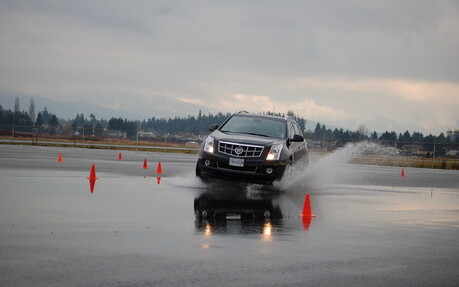2010 Cadillac SRX: The Crossover Caddy, Corrected.
The Cadillac SRX was a stupid idea. Debuting in 2004, it was intended to offer buyers a smaller, sportier alternative to the Escalade, but with gas prices still climbing towards their zenith and GM pricing the SRX just a few bucks below the range-topping Escalade, most buyers found more value in the bigger Cadillac SUV.
But it’s 2010 now, and things have changed. Higher gas prices are here to stay, and the recession has made Escalade-sized luxuries appear needlessly frivolous. This is, of course, bad news for Cadillac. With the huge GMT900-based Escalade no longer providing GM’s most luxurious company with ample profit margins, Cadillac needed to give their SUV buyers something smaller, cheaper, and better suited to today’s car-buying market. So, they took the SRX to the cleaners.
And it shrank. To be precise, it shrank into precisely what it should have been in 2004. Abandoning the large rear-wheel drive platform that underpinned the previous model, the new SRX is a decidedly car-like CUV that’s driven through the front wheels unless optioned out with an all-wheel drive system, as was my tester. It’s smaller under the hood too; available with either a 3.0L V6 or a 2.8L turbocharged V6; the smallest engines available under a Cadillac bonnet.
And that’s a problem, given the SRX is something of a porker. Weighing 4,307 pounds, the 3.0L V6 was anything but responsive when it came to the cut and thrust of inner city traffic. Feeling disconnected and uncooperative, the engine simply refuses to generate power below 30 kilometres per hour. Even at highway speed, you’re often compelled to check that you’ve disengaged the emergency brake. Oddly enough, although it feels lacklustre, passing manoeuvres are easily dispatched, and the speedometer records more accelerative properties than your derriere feels. As if that wasn't wierd enough, there are a few flat spots in the 3.0L V6’s powerband, which is superemely odd given the 3.0L is just a scaled-down version of the sizzling 3.6L V6 found in the CTS.
But while the 3.0L V6 is less than a star performer, the all-wheel drive system that backs it up is anything but. Developed with Haldex, the system uses electronic differential in the rear axle to shuttle torque both front to rear and side to side across the rear axle. To provide even more traction, an adjustable continuously variable suspension system continuously reads the road conditions and alters the shock’s damping rates accordingly. Tested on a closed course, the suspension and all-wheel drive system works phenomenally well. While I expected the SRX to throw its girth around the track in its best imitation of a mammoth sinking into a tar pit, the SRX was anything but. Slicing between the cones with surprising precision, it kept an even keel throughout while the all-wheel drive system kept the wheelspin under control. Not missing a beat, it dealt with untoward conditions perfectly, and not even a few inches of standing water on one corner’s exit could dissuade the SRX from holding its intended line. Braking performance was excellent and easily modulated, and although there was some dive, it was far less than one would expect.
Of course, the SRX’s surprising performance isn’t an accident; Cadillac never intended for this new SRX to be anything but sporty. And its interior belies that, with solid seating that provides plenty of support. The steering wheel will be familiar to those that have piloted a CTS lately; as will the entire cabin. Cadillac’s designers have done an excellent job of bringing the nouveau styling of the Cadillac line into the SRX, and everything feels subsequently top-notch. All the controls are easily utilized, and even the most thorough tossing about couldn’t convince any of the surfaces to elicit even the quietest squeak. In fact, the only issue that arose throughout the week’s test was the stereo’s occasional inability to communicate with my iPod. Otherwise, the tall seating position gave a commanding view over rush hour traffic without compromising the driver’s sense of control during more spirited driving.
After a week’s testing with Cadillac’s latest product, it’s evident that GM’s product planners have finally figured out the car buying public. While the Escalade will still maintain its position as the SUV flagship for the historic marquee, the SRX provides most buyers with a far more practical package that’s also far more attainable. With a base price that’s about $900 dollars higher than that of a CTS, the $41,575 base SRX offers entry-level buyers an all-weather Cadillac that may be more appealing to Canadians that the lower, sportier CTS.
| Test drive report | |
| Test model | 2010 Cadillac SRX |
|---|---|
| Trim level | Performance AWD |
| Price range | $41,575 – $62,770 |
| Price as tested | 52 065 $ |
| Warranty (basic) | 4 years/80,000 km |
| Warranty (powertrain) | 5 years/160,000 km |
| Fuel economy (city/highway/observed) | 12,2 / 8,8 / 12,8 L/100km |
| Options | 20" x 8" Aluminum Tech Wheels |
| Competitive models | Audi Q7, Lexus RX, BMW X5, Porsche Cayenne, Saab 9-7x, Volkswagen Touareg, Volvo XC90, Mercedes-Benz M-Class, Buick Enclave, Acura ZDX, Infiniti FX, Land Rover LR3, Acura MDX, Lincoln MKX |
| Strong points |
|
| Weak points |
|
| Editor's rating | |
| Fuel economy | |
| Value | |
| Styling | |
| Comfort | |
| Performance | |
| Overall | |
